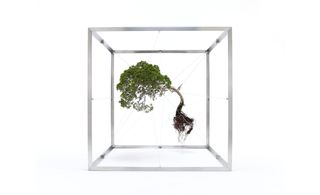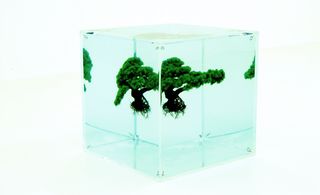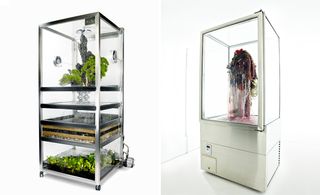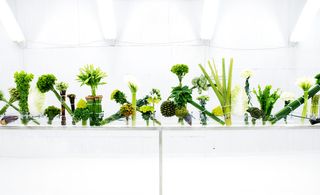Perrier-Jouët: The artist

Tokyo-based floral artist Makoto Azuma, whose work has been exhibited at Colette and Fondation Cartier in Paris, was well aware of the historical significance of this very particular commission. The Belle Époque bottle had not changed much since the head of Perrier-Jouët, Henri Gallice, asked the celebrated French glassmaker Émile Gallé to design a special magnum for his champagne in 1902.
It was an audaciously flamboyant move at the time; the art nouveau movement was in full swing and the clambering anemones testified to this adventurous new style, paying tribute to Japanese art and drawing inspiration from the primal force of nature, a central theme of art nouveau. The bottle design's organic lines and forms, criss-crossing stems and leaves illustrated the true spirit of the movement.
These motifs became the emblem of the Belle Époque cuvée and the iconic image of a champagne house that has become recognised the world over for its links to the art world. The bottle became an icon, famous for the distinctive, hand-painted Japanese anemones that cling to its green bottle and rise up its slender neck.
Equipped with this knowledge and appreciation of the champagne house's legacy, Azuma embarked on some vital research, which mostly involved tasting Perrier-Jouët champagne. 'The lightness and feeling of air in the mouth, the sensation of the popping and bursting of the champagne bubbles, these were my inspirations,' says Azuma.
Back in the quiet calm of his Tokyo studio, with the elegant effervescence of those defining flutes still fresh on his palate, the artist got down to work. He first surrounded himself with white flowers and Japanese foliage 'as a tribute to the anemones of Émile Gallé', recreating the classic Perrier-Jouët colour spectrum in his atelier. 'I wanted to make something extraordinary, taking inspiration from the sensation of champagne inside the mouth, and the delicate movement of the ivy and leaves with special attention given to the anemone.'
Ideas and inspiration came from myriad sources. Some tangible, others less concrete. 'Many people will tell you that they have profound memories - like, for instance, if you listen to a certain kind of music, it may remind you of a girlfriend or boyfriend,' he says. 'I want to evoke such memories through plants.'
www.perrier-jouet.com
Perrier-Jouët Facebook
Perrier-Jouët Twitter

Part of a series of artworks, titled 'Shiki', created to convey the conflict between man and nature

Part of a series of artworks, titled 'Shiki', created to convey the conflict between man and nature

Part of a series of artworks, titled 'Shiki', created to convey the conflict between man and nature

'Armoured pine', 2010. Azuma gives just the illusion of a pine tree using steel cages

Left, a new botanical environment by Azuma, titled 'Paludarium Suguru'. Right, 'Frozen Flowers'

'Botanical Sculputure #1 Assamblage', 2008. Azuma's living sculpture develops the concept of assembling plants by cutting, bending, binding and joining, rather than purely arranging
Wallpaper* Newsletter
Receive our daily digest of inspiration, escapism and design stories from around the world direct to your inbox
-
 Find yourself at Six Senses Kyoto, the brand's breathtaking Japan debut
Find yourself at Six Senses Kyoto, the brand's breathtaking Japan debutSix Senses Kyoto opens its doors boasting tranquil, luxurious interiors by Blink Design Group
By Danielle Demetriou Published
-
 Shigeru Ban’s mini Paper Log House welcomed at The Glass House
Shigeru Ban’s mini Paper Log House welcomed at The Glass House'Shigeru Ban: The Paper Log House' is shown at The Glass House in New Canaan, USA as the house museum of American architect Philip Johnson plays host to the Japanese architect’s model temporary home concept
By Adrian Madlener Published
-
 Artist Mickalene Thomas wrestles with notions of Black beauty, female empowerment and love
Artist Mickalene Thomas wrestles with notions of Black beauty, female empowerment and love'Mickalene Thomas: All About Love’, a touring exhibition, considers Black female representation
By Hannah Silver Published